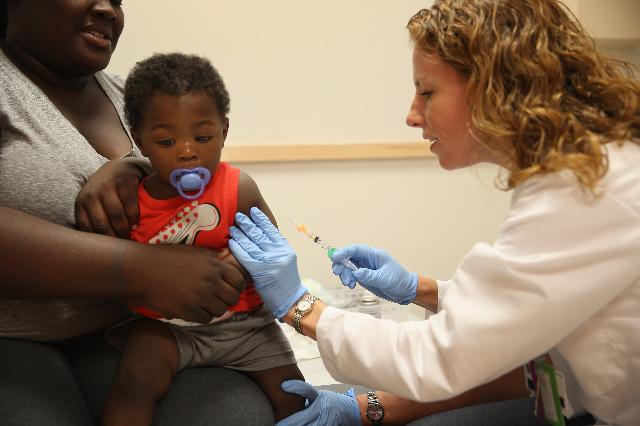Spraying a measles vaccine up children’s noses gave them some protection against measles but fell short of the immunity conferred by an individual measles vaccine injection in a study recently published in New England Journal of Medicine.
The randomized controlled trial was run in India with just over 2,000 children to see if the aerosol vaccine could achieve an effectiveness within five percentage points of the injection based on antibody levels in the blood. Among the 1,560 samples ultimately available for testing (after exclusions and a substantial number of samples that were damaged), the 85.4 percent of the children receiving the aerosol vaccine had sufficient antibody levels, and 94.6 percent of those who received injections had protection. The proportion of children protected therefore ended up 9 percentage points short of the shot’s levels, leading the researchers to conclude that the aerosol vaccine was inferior, not least because measles requires such a high level of herd immunity – about 95 percent – to prevent its spread through a population.
Still, the findings were encouraging, said Dr. Gregory Poland, founder and head of the Vaccine Research Group at Mayo Clinic in Rochester, Minn. Poland, who specializes in researching measles vaccines, explained the number of advantages aerosol vaccines offer. “In terms of a daycare center or school, to be able to go in and administer a vaccine with an aerosol is cheaper, faster, more acceptable – certainly to the children – and has no risk of any sort of sharps injury,” he said.
But there’s another advantage to certain aerosol vaccines that has to do with immunology and the way the disease is transmitted. Our immune systems respond to foreign invaders from the moment they enter our bodies, not just later on if they reach the bloodstream. “One of the reasons that we deliver vaccines either intranasally or via the respiratory route is to stimulate local immunity, the response at the portal of entry,” Poland said. “For example, with influenza, we breathe it in through our nose and mouth, and a very effective way to immunize adults and young children is intranasally with a spray because you’re producing immunity right at the site.”
Yet, interestingly, the researchers of this study only measured antibodies levels in the blood, not the localized response. They sold themselves short, Poland suggested. “I think the investigators are overlooking a potentially important aspect of the aerosolized vaccine,” he said. “I don’t think it’s fair to hold the aerosolized vaccine to the same level of antibody bar that we would the injectable vaccine.”

The only measles vaccine currently available in the U.S. is the one within the MMR (measles-mumps-rubella) injection. But researchers throughout the world are seeking better ways to deliver vaccines that can be as effective. Here, India Ampah holds her son, Keon Lockhart, 12 months old, as pediatrician Amanda Porro M.D. administers a measles vaccination during a visit to the Miami Children’s Hospital on June 02, 2014 in Miami, Florida. (Photo by Joe Raedle/Getty Images)
Aerosol measles vaccines aren’t new. In fact, Mexico has used one for more than 4 million children since 1980. But data from those immunizations and then studies like this, conducted in India, cannot necessarily tell us much about how well the vaccine would perform in the U.S. The children in this study appeared, based on their height and weight provided, to be underweight and most likely were deficient in vitamin A and D, Poland said. Those deficiencies can affect how effectively the body responds to a vaccine, and certainly those children have different nutritional statuses to American kids.
Even an aerosol measles vaccine that is slightly inferior to the injection could have value in places such as India, however, primarily due to population and healthcare infrastructure differences from more higher income countries. There are many, many more kids needing vaccinations across India, from slums in big cities to the outermost villages, than in any high-income country. Many of these areas might lack the trained healthcare personnel and the facilities to keep up with demand in administering measles vaccine injections. But an aerosol vaccine is fast and efficient and doesn’t require the same level of training for administration. A slightly inferior vaccine which can be used more widely more quickly and efficiently may end up providing greater overall protection than a slightly better vaccine that doesn’t reach nearly as many children. In addition, no serious adverse events occurred in this trial (and the authors note that the data and safety monitoring board overseeing the study had the authority to stop the trial if a single serious adverse event was judged as caused by the vaccine).
The U.S. is more fortunate in terms of healthcare infrastructure, making it unlikely than an aerosol measles vaccine would be in the near future here, especially since the safe and effective one within the MMR already exists. Further, the path of a vaccine from concept to FDA licensure and market costs upwards of $1 billion, Poland pointed out, and that’s a significant investment to make unless the vaccine is actually equal or superior to the current one. But if the vaccine succeeds in enough other countries after some tweaking, it’s not impossible to imagine it eventually making its way to U.S. markets as long as the effectiveness is high enough.
“I think it absolutely deserves attention, more research funds and further trials,” Poland said. “We have generally done well when we follow the path carved by Mother Nature. If the way these bugs enter is via respiratory route, then lets immunize via a respiratory route.”
